Pad see ew is the perennial street food for the Thais. It is one dish that is easy to prepare, as only a few ingredients are required, and the cooking is simple. It is so popular that it is served in every Thai restaurant and street vendor.
See Ew is phonetically similar to the word for soy sauce in Chinese. Not mistakenly, it is a fried noodles dish prepared with soy sauce.
This Thai food is as simple as is described, but you need to pay attention to a few points to make an excellent pad see ew.
The following set of notes explains each ingredient and the steps in detail.
Let’s get into the details without further ado.
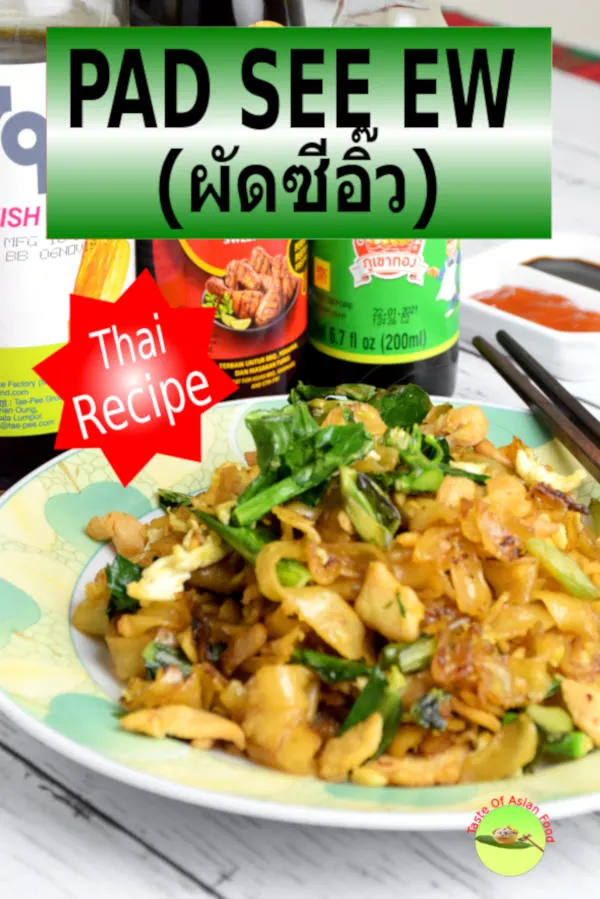
Note: This post may contain affiliate links. Please read my privacy policy for more info. I may receive commissions for purchases made through links in this post. As an Amazon Associate, I earn from qualifying purchases.
1. The ingredients for Pad See Ew
a. The protein: Meat or tofu
Chicken, pork, and beef are all suitable for pad see ew. Use tofu if you prefer a vegetarian dish.
The general principle is to cut the meat into small, thin slices. Marinate it with a small amount of light soy sauce to enhance its flavor, a bit of cornflour for a smoother texture, and some vegetable oil. Set aside for thirty minutes before stir-frying.
The marinated meat has a much better flavor than the non-marinated counterparts. I suggest you do not omit this simple step.
You can substitute the meat with firm tofu for a vegetarian pad see ew.
b. The eggs – the flavor enhancer
The egg is an essential ingredient for all fried noodles.
Add the egg in the later part of stir-frying. Spread the egg thinly and let it partially cook. Fold the noodle to the egg so that some egg will stick to the noodles, and the rest will stay free as small yellow pieces.
I prefer to add the egg before adding the Chinese broccoli leaves so that it will not stick to the vegetable, but this is a personal preference, and there is no rulebook to follow.
c. The flat rice noodles (Sen Yai/Keow Teow) for Pad See Ew
As a Malaysian, I am familiar with another local street food called Char Keow Teow. Char Keow Teow and pad see ew use flat rice noodles called Sen Yai or Keow Teow, called Hor Fun in Cantonese.
I want to mention Char Keow Teow because it is almost identical to pad see ew. The main difference is that the Thai version uses virtually exclusively Chinese broccoli and meat, but the Malaysian Char Keow Teow uses a combination of Chinese chives, cockles, bean sprouts, and slices of Chinese sausage.
Here is the image of the fresh rice noodles. You can get it from your nearby Asian market. Use the dry rice noodles if you can’t get fresh wide rice noodles, but it is not the best option. Follow the packaging instructions to rehydrate the dry noodles before using them. If you still can’t get any such noodles, you can use the egg noodles to prepare according to the same instructions.
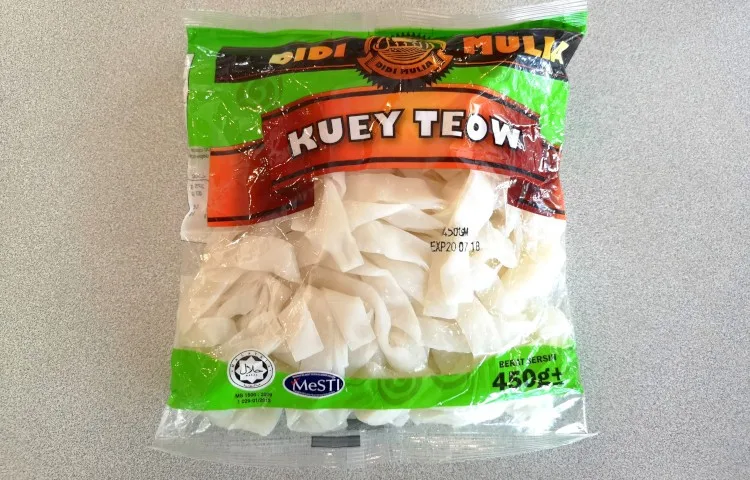
Fresh Keow Teow is quite oily and tends to stick together. Separate the noodles by hand before frying it, as the whole stack of noodles tends to stick together during stir-frying.
You should leave the fresh noodles at room temperature. The noodles tend to turn into a hard block in the fridge. You must leave it at room temperature until it softens before frying it. You can also use the microwave oven to soften it. It can be kept at room temperature for four to five days.
d. The vegetables – Chinese broccoli (Gai Lan)
Chinese broccoli is the key ingredient for preparing pad see ew.
There is a significant difference between Chinese broccoli and regular broccoli. Chinese broccoli is leafy, without florets.
You need to use this vegetable for cooking the authentic pad see ew. The following is the image, which will help you to look for it in Asian supermarkets and grocery shops. The next best thing is to substitute green vegetables, such as bok choy or choy sum.
Cut the leafy part of the Chinese broccoli into a few sections. Remove the tough fiber on the surface with a vegetable peeler. Cut them diagonally into small pieces.
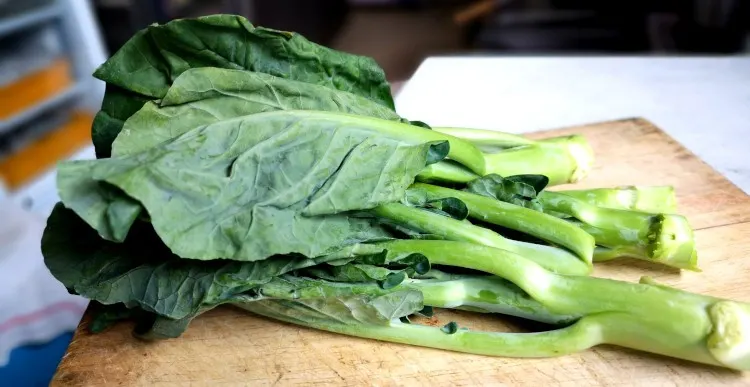
e. The seasonings – the Thai light soy sauce is irreplaceable
The key ingredients to season pad see ew is soy sauce, which means ‘see ew.’ The recipe has two types of soy sauce: light and dark soy sauce. Thai’s light soy sauce may be hard to get outside of Thailand, but it is irreplaceable as it has a unique taste. The Thai brand Golden Mountain is readily available in Malaysia. You can also purchase online from Amazon.
The closest substitute for the Thai sweet dark soy sauce I can get is the Indonesian kicap manis. The ABC brand from Indonesia is available in most local supermarkets, which produce the flavor closest to the authentic Thai version.
The third important item is oyster sauce. Some cooks omit oyster sauce in the formula, but I use it as it gives a wholesome flavor to the noodles. A vegetarian oyster sauce is also available, made with mushroom extract but tastes like oyster sauce.
I like to include a small amount of fish sauce in the seasoning. It has umami and a sharp salt flavor.
These four ingredients plus a bit of sugar are all the seasoning required for pad see ew.
f. The Aromatic- chopped garlic
The aromatic for pad see ew is simple. I just chopped garlic alone. Coarsely chop the garlic and sauté with the meat in vegetable oil over low flame until fragrant. Be careful not to brown the garlic too much, as it will turn bitter.
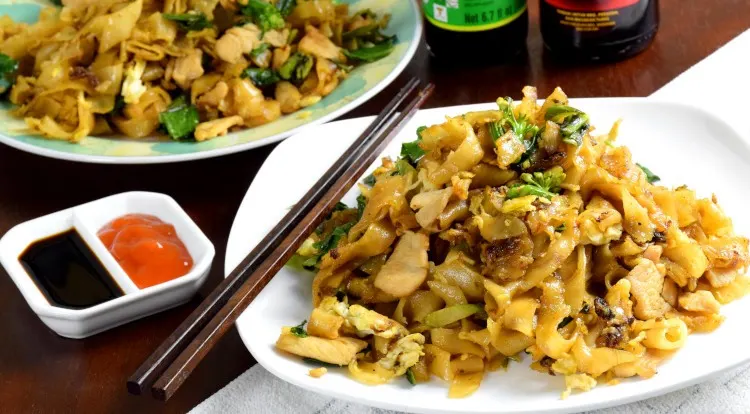
2. How to cook Pad See Ew – the step-by-step process
a. Cook the stem of the Chinese broccoli
- Start with cooking the stems of the Chinese broccoli.
- Stir-fry over medium heat with some vegetable oil for about a minute.
- Add three tablespoons of water (to the 6 stalks of Chinese broccoli I use) and cook it for another two minutes. Blanch the stems until it is soft (you can pick one and test it). Turn up the heat to dry up any remaining water.
- Dish out or push them to the side of the wok.
b. Cook the meat with the chopped garlic
- Sautéing the garlic with some oil over low heat.
- Keep the heat low so the oil is bubbling with the garlic. Garlic can burn quickly over high heat and become bitter.
- Add the marinated meat to it and stir-fry until the meat is cooked. Spread the chicken into a single layer and pan-fried until slightly brown.
- If you use beef, remove it as soon as it is cooked. Beef will become tough if it is overcooked.
c. Fried the noodles
- Separate the fresh noodles by hand, so they do not stick to each other like a stack of cards. The loosened noodles have a larger surface to contact with the wok and char beautifully.
- Fried the noodles with some oil over low heat. Make sure you use a well-seasoned wok, as rice noodles tend to stick easily. If you are unsure how to season the wok, check out these articles, which explain how to do it (and the science behind the process). If you do not possess a wok, you can use a large skillet that can withstand high heat, preferably a cast iron skillet.
If you are using dry noodles, follow the package instructions. If there are no instructions given, measure half of the amount of the fresh noodles. For example, if the quantity in the recipe is 200g of fresh noodles, measure 100g of dry noodles and soak them in water until fully hydrated and soft. The final weight of the hydrated noodles (after draining) should be around 200g.
d. Add the seasoning (pad see ew sauce mixture)- soy sauce, oyster sauce, fish oil, sugar
Stir-fry is a quick cooking process. It allows us to have very little time for ad hoc preparation. Therefore, it is better to measure all the ingredients in advance. All you need is to pour the seasoning mixture into the noodles without worrying about the accuracy of the amount.
Most of the street vendors premix the seasoning for their convenience. They keep it in a bottle and squeeze out the amount required directly into the wok with high accuracy through years of practice and experience. You can emulate them similarly by premixing the sauce in a small bowl.
Once the noodles start to stick to the surface, add the seasonings (oyster sauce, soy sauce, and fish sauce). You can add one tablespoon of water if it is too dry. Gradually increase the heat to medium. Stir, flip and scrap lightly to avoid the noodles from sticking. It will not stick if the wok is well seasoned. Reduce the heat if it still sticks.
Pour half of the broccoli leaves and meat back into the wok, and stir well with the noodles.
e. Crack an egg
- Add the egg when the noodles are almost ready.
- Push the noodles to the side of the wok. Add a bit of oil if necessary.
- Crack an egg and spread it to form a single layer with the wok spatula. When the egg is partially cooked and looks like the scrambled egg, fold the noodles on top, flip, and stir while the egg is not fully set.
- Part of the egg will stick to the noodles, and the rest will stay free as small little yellow pieces.
f. Create the wok-hei
Increase the heat from medium to high and swiftly flip and glide the wok spatula on the wok surface. High heat will create the signature wok aroma called wok-hei that you are familiar with in Thai restaurants.
Finally, add the remaining broccoli leaves and stir-fry until the leaves are wilt.
How high is the high heat that means?
It is when you feel the heat and smoke start to rise from the wok. It is also when you have to glide/scrape continually your wok spatula on the wok to avoid the food from sticking.
The noodles will start to become slightly charred at the edges and caramelized. This is the end point of stir-frying. If you continue stir-frying pass through this point, the morsel of food in the wok will tend to get burned.
Once it is done, dish it out, garnish it with green onions, and season it with a dash of white pepper and a squeeze of lime juice..
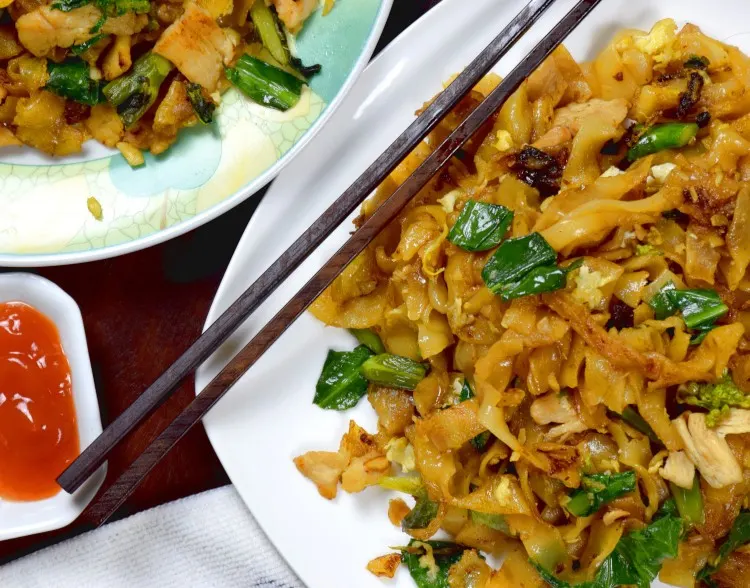
3. The fine points of the cooking pad see ew
a. Cooking with beef
If you prepare a beef pad see ew, you should remove the beef once it is cooked. Add the bite-sized pieces of beef to the noodles only after the noodles are charred slightly. This is to prevent the beef from being overcooked.
b. The wok hei
Always start to cook with low heat (saute the garlic), then medium heat (cooking the meat and vegetables and egg), and finally at high temperature (to create wok hei and char the flat noodle). The excellent and mediocre noodles stir-fries are defined by the aroma formed with high temperature through the Maillard reaction.
High heat will char the noodles and generate the signature aroma of stir-frying. This does not mean that the higher the heat, the better it will be, as you need to ensure every morsel of food on the hot surface of the wok does not get burned. If this happens, it will leave a bitter taste to the noodles, and the burnt debris will stick on to the noodles, which the Cantonese chef describes as 镬屎.
c. The choice of seasonings
Have a few trial-and-error sessions before setting the exact amount of seasoning you prefer.
The reason: each brand of soy sauce has a slightly different level of saltiness. You need to readjust the amount once you substitute the Thai soy sauce with the Chinese dark soy sauce or the Indonesian kicap manis. Start cooking with the quantity in this recipe and adjust accordingly.
d. Stir-fry one plate at a time
The maximum amount that you can stir-fry with good results is likely to be about 300g of noodles, based on the average power of the conventional stove. The reputable street food vendors insist on stir-frying one plate at a time even though they use a high-power stove.
The heat generated by an average stove is inadequate to cook more than this amount efficiently. Stir-frying is a quick process with intense heat, especially during generating wok-hei. The wok-hei will not be created if the amount of noodles is too much.
Other Thai recipes you may want to try if you like Pad See Ew
- By this Thai basil fried rice recipe. It is created by using fresh basil and Thai chili paste.
- If you like Thai noodle dishes, try this traditional pad Thai recipe.
- Try the Thai drunken noodles, prepared with plenty of chilies and basil.
The Pad See Ew recipe
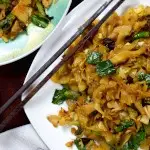
Pad see ew is the perennial stable food for the Thai’s. It is one dish that is easy to prepare, as there are only a few ingredients required, and the cooking is simple.
Ingredients
Ingredients to marinate the meat
- 150 g chicken breast meat, thinly sliced, can be substituted with beef or pork
- 1 tbsp light soy sauce
- 1/2 tsp cornflour
- 1 tsp vegetable oil
Ingredients for the seasonings
- 2 tbsp oyster sauce
- 1 tsp fish sauce
- 5 tsp Golden Mountain Seasoning Soybean Sauce
- 2 tsp sweet soy sauce, ABC brand
- 2 tsp sugar
Other ingredients
- 4 tbsp vegetable oil, for frying
- 1 tbsp chopped garlic
- 2 eggs
- 6 stalks Chinese broccoli, also called gailan
- 450 g fresh wide rice noodles also called sen yai or keoy teow
- Ground white pepper, to taste
Instructions
Preparation
- Cut the meat into small, thin slices.
- Marinate it with a small amount of light soy sauce, a bit of cornflour, and some vegetable oil.
- Set aside for thirty minutes before stir-frying.
- Cut the leafy part of the Chinese broccoli into a few sections. Remove the tough fiber on the surface with a vegetable peeler. Cut them diagonally into small pieces.
- Cut the stems diagonally into short sections.
Cooking
- Stir-fry the Chinese broccoli over medium heat with some vegetable oil for about a minute. Blanch the stems until it is soft. Turn up the heat to dry up any remaining water. Dish out or push them to the side of the wok.
- Cook the meat with the chopped garlic
- Sautéing the garlic with some oil over low heat. Add the marinated meat into it and stir-fry until the meat is cooked. Spread the chicken into a single layer and pan-fried until slightly brown.
- Fried the noodles. Once the noodles start to stick to the surface, add the seasonings
- Pour half of the broccoli leaves and meat back to the wok, stir well with the noodles.
- Crack an egg and spread it to form a single layer with the wok spatula. When the egg is partially cooked and looks like the scrambled egg, fold the noodles on top of the egg and have a quick flip and stir while the egg is not fully set.
- Finally, add the remaining broccoli leaves into the wok. Stir-fry until the leaves are wilt.
Recommended Products
As an Amazon Associate and member of other affiliate programs, I earn from qualifying purchases.
Nutrition Information:
Yield:
2Serving Size:
2 platesAmount Per Serving: Calories: 1076Total Fat: 55gSaturated Fat: 10gTrans Fat: 1gUnsaturated Fat: 39gCholesterol: 325mgSodium: 5819mgCarbohydrates: 83gFiber: 11gSugar: 14gProtein: 62g
This data was provided and calculated by Nutritionix on 3/25/2019

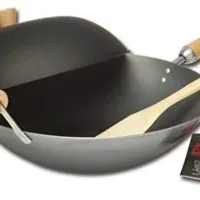
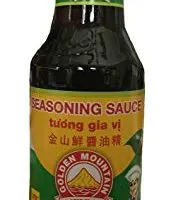
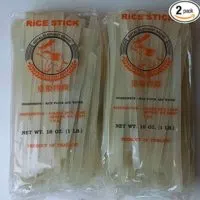
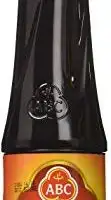
Donna Amberly
Tuesday 31st of January 2023
This was just the best recipe I have found. I just all the flavors. Thanks for the recipe
Stephanie
Monday 5th of September 2022
This is the best/most helpful recipe that I’ve found for pad see ew. Thank you for all your tips!!
Keith
Wednesday 16th of February 2022
This meal looks delicious. Looking forward to trying it. But I regularly cook (very much an amateur) for eight men. should I multiply the ingredients by 4? Thank you
KP Kwan
Friday 18th of February 2022
You only need to multiply all the ingredients when cooking for more people.
Kimberly Bergman
Monday 6th of September 2021
Is there any substitution for the Soybean sauce? Have all the ingredients but this one
KP Kwan
Monday 6th of September 2021
Light soy sauce and fish sauce are both the key ingredients. I hope you can get it from the Asian grocery store near you.
Pete
Wednesday 7th of April 2021
Thank you so much for writing this up! It's easy to find recipes for dishes like pad see ew online, but very rare to find them written up in such detail with all the nuances and common pitfalls explained. I'm understanding better why some of my past efforts have fallen short.